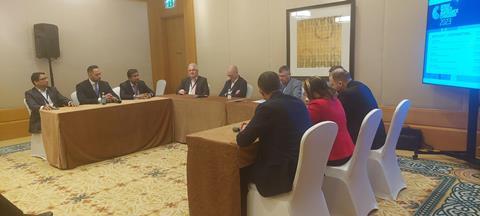A DWIC roundtable on underwriting discussed the impact of hardening reinsurance rates and new technology
The roundtable at Day Two of the Dubai World Insurance Congress 2023 – titled ‘Underwriting: The challenges and opportunities’ - was chaired by industry veteran Yassir Albaharna Group CEO & Executive Director, Trust Re, and attended by:
- Tareq Hussein, Head Of Specialty Lines, Mena Re Underwriters;
- Steven Wallace, Managing Director for UK & Ireland, McLarens;
- Souvik Goswami, Director – Reinsurance, Tysers Insurance Brokers;
- Peter Burton Executive Director-International Markets, QBE UK;
- Mohamed Kotb, Managing Director – Treaty Division, United Insurance Brokers;
- Lavanya Mundayur, Chief Operating Officer, The New India Assurance Co.;
- Evelyne Wanjohi, Associate General Manager, Acentria International Reinsurance Company;
- Deyaa El Sawy, Senior Director, Chedid Reinsurance; and
- Dermot Dick, Head Of Energy, Oneglobal Broking.
Days of ‘free capital’ are over
The first challenge they discussed was how to maintain underwriting discipline moving forward. One panellist said the key to achieving this was consistency across the board, rather than focusing too deeply on individual risks.
”The important thing,” he said, ”is to design and build the portfolio and that should be priced consistently.”
“It’s never the right price when a claim happens,” quipped an underwriter.
In reality, the majority of carriers follow the market when it comes to pricing, acknowledged the speakers. “If we don’t, it isn’t a class of business we should be in,” said one. “The reality is there’s no true technical pricing. It’s all about what the market dictates.”
Art or science?
Underwriters should not rely too much on their pricing models, thought some. For specialty and reinsurance classes of business, there is still an ‘art’ to underwriting that comes with long experience, instinct and relationships.
One thought the art of underwriting was getting lost and jeapordising long-standing relationships between cedants and reinsurers in the process. “Are you an underwriter or an under-rater?” he asked.
After many years of a soft market in the GCC and wider region, the lack of “soft and almost free capital” may come as a shock to the underlying market, thought some speakers.
The reinsurance market is hardening globally, with less capacity available, pricing up considerably and terms and conditions tightening.
“The retrocession market is hardening and what we see on the retail side is a huge gap,” commented a local insurance executive. ”Companies are not up to speed on what’s happening in the international markets and they are getting caught out.”
“There’s a huge gap between insurance pricing and reinsurance.”

Potential uses of AI
One speaker said AI will have a direct impact on the underwriting of claims and also the likelihood of those claims.
“I am most interested to see the impact AI will have on risk mitigation, stopping the claim from happening to begin with and the impact that will have on the price,” said the speaker.
“In a perfect world we would like to develop an AI that will ultimately drive the pricing down on the premiums too. This will be the main advantage to the industry as a whole.”
Another speaker said that while conversations have started about using AI, they are still largely inclined towards using underwriting professionals to guide on its pricing for claims.
Human-driven
One speaker noted that despite its uses, AI “does not drop from above”, as it is still created to act in a certain way by humans.
“AI is ultimately somebody’s brain who was thinking about and creating formulas. It is human intelligence put into a system and being sold as AI. It is my intelligence. I have created the formula,” said the speaker.
“How can AI know if to accept a risk or not accept a risk? Insurance will always be a combination of art and science – and getting that balance right is what counts.”
In reply to this point, another speaker noted that AI in insurance is not being designed as a risk decision-maker, but rather to aid in the decision-making process.
“Even the human brain has limitations. An AI is able to simulate effects within microseconds or nanoseconds of all the experiences and all the losses that happened all over the years. It can then aid you in a decision. It enables you to see patterns, which is difficult for the human brain.”
Techno-lagging
While AI emanates as a major technology buzzword, the roundtable spoke more broadly about the opportunity with technology, and at times the industry’s failings.
“I have been in underwriting for 40 years and at this stage of my career I am not a huge fan of technology, but our inability as an industry to adopt proper modern technology and upgrade our systems to do a better job this is quite frankly disgraceful,” said the speaker.
“In my market, before we start messing around with AI, we need proper electronic trading. We need contract certainty. Let’s get documentations done automatically. We have a lot to do in our industry to make ourselves more efficient and do a better job for all of our clients.”
However, another speaker warned: “The technology piece is quite fascinating because in my organisation, we talk an awful lot about technology.
“However, I have yet to see the introduction of any technology which actually makes us more efficient, or made the underwriter’s job easier, or replaced a person’s job.
“The answer is we have to evolve. We have to embrace technology, but whatever we are doing at the moment in the industry is not landing properly yet.”










No comments yet